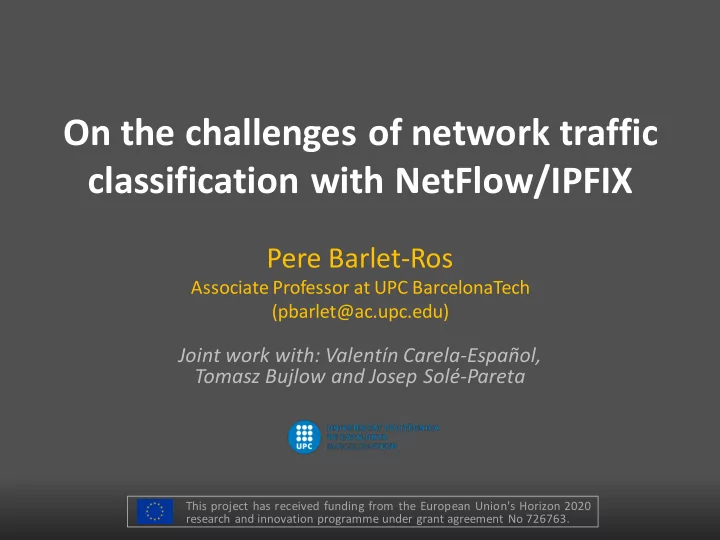

On the challenges of network traffic classification with NetFlow/IPFIX Pere Barlet-Ros Associate Professor at UPC BarcelonaTech (pbarlet@ac.upc.edu) Joint work with: Valentín Carela-Español, Tomasz Bujlow and Josep Solé-Pareta This project has received funding from the European Union's Horizon 2020 research and innovation programme under grant agreement No 726763.
Background • What do we refer to as traffic classification ? – Identifying the application that generated each flow • What is traffic classification used for? – Network planning and dimensioning – Per-application performance evaluation – Traffic steering / QoS / SLA validation – Charging and billing 2
Background: Ports • Port-based – Computationally lightweight – Payloads not needed – Easy to understand and program – Low accuracy / completeness (but most NetFlow products still use it!) 3
Background: DPI • Deep packet inspection (DPI) – High accuracy and completeness – Computationally expensive – Needs payload access – Privacy concerns – Cannot work with encrypted traffic 4
Background: ML • Machine Learning – High accuracy and completeness – Computationally viable – Payloads not needed – Can work with encrypted traffic – Needs frequent retraining 5
Main limitations of ML-TC • Introduction in real products and operational environments is limited and slow – Current proposals suffer from practical problems – Actual products rely on simpler methods or DPI • 3 main real-world challenges: 1) The deployment problem 2) The maintenance problem 3) The validation problem 6
1) Deployment problem • Current solutions are difficult to deploy – Need dedicated hardware appliances / probes – Need packet- level access (e.g. compute features, …) • How to address this problem? – Work with flow level data (e.g. Netflow / IPFIX) – Support packet sampling (e.g. Sampled Netflow) 7
NetFlow w/o sampling • Challenge: NetFlow v5 features are very limited – IPs, ports, protocol, TCP flags, duration, #pkts , … • State-of-the-art ML technique: C4.5 decision tree 8
Results (NetFlow w/o sampling) • UPC dataset: Real traffic from university access link – 7 x 15 min traces (collected at different days / hours) – Labelled with L7-filter (strict version with less FPR) – Public data set available at: https://cba.upc.edu/monitoring/traffic-classification 9
Results (Sampled NetFlow) • Impact of packet sampling 10
Sources of inaccuracy 1) Error in the estimation of the traffic features 2) Changes in flow size distribution 3) Changes in flow splitting probability 11
Solution (Sampled NetFlow) V. Carela-Español, P . Barlet-Ros, A. Cabellos-Aparicio, J. Solé-Pareta. Analysis of the impact of sampling on NetFlow traffic classification . Computer Networks , 55(5), 2011. 12
2) Maintenance problem • Difficult to keep classification model updated – Traffic changes, application updates, new applications – Involve significant human intervention – ML models need to be frequently retrained • Possible solution to the problem – Make retraining automatic – Computationally viable – Without human intervention 13
Autonomic Traffic Classification • Lightweight DPI for retraining – Small traffic sample (e.g. 1/10000 flow sampling) 14
Results • 14-days trace collected at the Anella Científica (Catalan RREN) managed by CSUC (www.csuc.cat) V. Carela-Español, P . Barlet-Ros, O. Mula-Valls, J. Solé-Pareta. An autonomic traffic classification system for network operation and management . Journal of Network and Systems Management , 23(3):401-419, 2015. 15
3) Validation problem • Current proposals are difficult to validate , compare and reproduce – Private datasets – Different ground-truth generators • Our contribution – Publication of labeled datasets (with payloads) – Common benchmark to validate/compare/reproduce – Validation of common ground-truth generators 16
Methodology • Manually generate representative traffic – Create fake accounts (e.g. Gmail, Facebook, Twitter) – Interact with the service simulating human behavior (e.g. posting, gaming, watching videos, skype calls …) 17
Data set • Public labeled data set with full payloads – Accurate: VBS (label from the application socket) – Avoids privacy issues: Realistic “artificial” traffic – Limitations: Traffic mix might not be representative • Data set is publicly available at: – http://www.cba.upc.edu/monitoring/traffic-classification – Shared with 200+ researchers over the world – Cited in 100+ scientific articles (source: Google Scholar) 18
Data set • > 750K flows, ~55 GB of data • 17 application protocols – DNS, HTTP, SMTP, IMAP, POP3, SSH, NTP, RTMP, … • 25 applications – Bittorrent, Dropbox, Skype, Spotify, WoW , … • 34 web services – Youtube, Facebook, Twitter, LinkedIn, Ebay , … T. Bujlow, V. Carela-Español, P. Barlet-Ros. Independent comparison of popular DPI tools for traffic classification . Computer Networks , 76:75-89, 2015. V. Carela-Español, T. Bujlow, P. Barlet-Ros. Is our ground-truth for traffic classification reliable? In Proc. of Passive and Active Measurement Conf. (PAM), 2014. 19
DPI tools compared 20
Results: Application protocols • Most tools achieve 70%-100% accuracy • nDPI and Libprotoident showed highest completeness (15/17) • Only Libprotoident identified encrypted protocols (e.g., IMAP TLS, POP TLS, SMTP TLS) • L7-filter suffered from false positives (9/17) 21
Results: Applications • 20-30% less accuracy compared to protocols • PACE (20/22) and nDPI (17/22) obtained highest completeness • Libprotoident showed reasonable acc. (14/22) – Note it only uses 4 bytes of the payload • NBAR showed very low performance (4/22) – Unable to classify most applications 22
Results: Web services • PACE: 16/34 (6 over 80%) • nDPI: 10/34 (6 over 80%) • OpenDPI: 2/34 • Libprotoident: 0/34 • L7-filter: 0/44 (high FPR) • NBAR: 0/34 23
Implications for operators • Current DPI products are expensive and difficult to deploy • Accurate traffic classification with Sampled NetFlow is possible and easy to deploy • Sampled NetFlow traffic volumes are low – Flows can be easily sent (encrypted) to the cloud – Monitoring can be offered as a service (SaaS) 24
Real implementation • Received funding from EU H2020 to convert technology into a commercial product – SME Instrument Phase 2 project – Grant agreement No. 726763 • Talaia Networks, S.L. (www.talaia.io) – Spin-off of UPC Barcelona-Tech – Monitoring and security service (SaaS and on-prem) – Customers worldwide (operators, ISPs, cloud prov., …) 25
On-Line Demo https://www.talaia.io 26
Recommend
More recommend